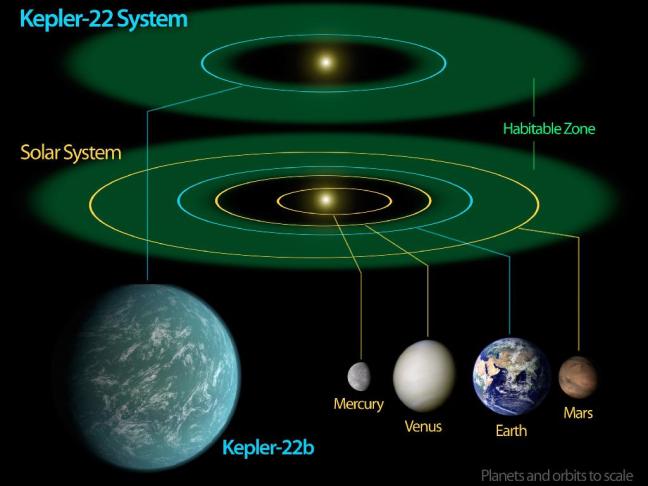It’s been a real pleasure to take my theoretical work on the habitability of exomoons out into reality, with the Hunt for Exomoons with Kepler (HEK) team. We’ve recently had this paper accepted for publication, where we used the Kepler Space Telescope’s data on Kepler-22b to search for an exomoon around it.

Kepler-22b was the first transiting exoplanet to be detected inside the habitable zone of its host star, a G type star very much like our Sun. As you no doubt know, the habitable zone is the region around a star where, if you placed a planet like the Earth, you would expect the surface water to be warm enough to be liquid, and potentially suitable for life. Sadly, Kepler-22b is not a planet like the Earth. We know this because its radius is 2.4 times that of the Earth (for comparison, Neptune is about 4 Earth Radii, and Jupiter is about 10 Earth Radii). We don’t know its mass for certain, but until now we knew that it couldn’t be any larger than 82 times that of the Earth(!).
It’s not clear at this point whether Kepler-22b is a really massive terrestrial planet, or a mini Neptune, but it’s clear that it’s not Earthlike, so its position in the habitable zone doesn’t mean very much for astrobiologists. However, if Kepler-22b had moons the same mass as the Earth, then those moons could themselves be habitable.
Exomoons are hard to detect directly, but they can be detected indirectly by studying their host planet in detail. If Kepler-22b has an exomoon of a sufficiently high mass, then we would be able to see the effects of the exomoon’s gravitational pull on the exoplanet in transit data. Transits rely on the planet obscuring starlight as it passes in front of it. The moon would show itself by subtly altering the time between individual transits, as well as how long the transits last for.
The HEK team have been searching the Kepler transit data for a few years without success (so far). This might sound a bit negative, but this lack of results still tell us something about how frequently moons of a given mass exist in the Galaxy. Kepler 22b is HEK’s first attempt to spot a moon in the habitable zone. A detection here would be pretty amazing…
Alas, we did not detect an exomoon around Kepler-22b – at least, no moon bigger than half an Earth mass. A non-detection is not as fun as a detection would have been, but a null result is a result nonetheless. And don’t forget, the moons of our Solar System are nowhere near as big as half an Earth mass – Saturn’s moon Titan is about 0.02 Earth masses – so we can’t say for certain that Kepler-22b is moonless. Also, this very in-depth analysis brings out extra info about Kepler-22b itself. The upper limit for Kepler-22b’s mass is now a mere 53 Earth masses instead of 82, and its orbit is known to much greater certainty than it was before.
So why was I involved in this work? My job was to help the HEK team assess how well they can detect exomoons – in particular, how well they can determine if an exomoon is habitable. The team injected a fake moon into the transit data, and then used their software to see if they could find it. The algorithm they use doesn’t give data for one moon out as an answer – instead, it gives a whole selection of moons, with properties clustered around the “true” values. This is a way of expressing the uncertainty or error bars in the answer.
I took this selection of moons, and ran each one through the climate models I developed. This gives a series of climates, some warm, some hot and some cold. I also ran the “true” moon through the model, giving the “true” climate of the moon, which it turns out was warm.

I was pleased to find that the selection of moons produced by the algorithm produced climates that were on the whole very similar to the true climate. So, the algorithm does a very good job of determining an exomoon’s properties – good enough for us to be confident enough to determine if the moon could be habitable.
It’s just a shame there wasn’t a real moon for us to find…
One thought on “Search for Exomoons Around Kepler-22b Strikes Out (This Time)”